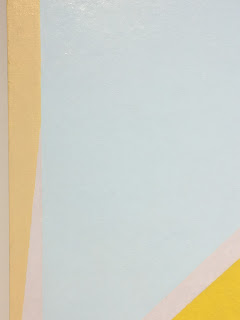Sterling Ruby
BC (3442), 2011
Collage, paint, bleach and fabric on stretcher
Christopher Wool
Untitled, 2012
Silkscreen on linen
Albert Oehlen
Untitled (Baum 3), 2014
Oil on disband
Wade Guyton
Untitled, 2007
Epson UltraChrome inkjet on linen
Wade Guyton
Untitled, 2009
Epson UltraChrome inkjet on linen
Carol Bove
Peel's foe, not a set animal, laminates a tone of sleep, 2013
Brass and concrete
Damian Ortega
Building #4, 2009
Unique structure, eroded bricks, and metallic internal support
Oscar Tuazon
Another False Wall, 2013
Plaster, cement, clay, and steel
Playboy Papecrate, 2012/2013
Concrete, paper, wood
Bleach, 2013
Plaster, blue paint, and steel
There were numerous directions to go in terms of how to look at this inaugural show in such a highly codified space, a building steeped in, well, building history and mystery, one that houses a private collection of art works that we are asked to consider in terms of process (therefore time) and archaeological status (which is to say artifact of a particular time). Perhaps a bit redundant, it still seemed worth considering time as a series of moves and as static moments. As luck would have it, my own preferences seemed to align nicely with this agenda. As such, the images I share are the works I found most interesting according to such criteria as well as less tangible aspects of looking and liking. mysteries to be sure.
Much could also be made of props, architecture and quests for freedom. cf. the opening image of this post and the few that follow (elements of the building symbolizing its former purpose). As one scrolls through this post from the beginning, it is worth noting a thread between them, that the form and transitions between works has a kind of seamlessness which may underscore said themes and purposes and also suture art and architecture in interesting ways: modularity and materials.
At times, the architectural fixtures were potently more interesting, and yet heightened by the collection of viewable works. Such symbioses may be worthwhile had such intent been magnified purposefully or had there not have been so many works pressed together into typical arrangements/associations. It seems cliche to even mention how sprawling group shows must often be disclaimed by such complications. Had this show taken a different route with fewer works and deeper connections, not only would the viewer have had a chance to absorb the consequences of process and archaeology, but also to view works independently as each artist intended. On the other hand, such issues of history and time are known to be (necessarily) messy, and the secrets of modern societies and art institutions are to be paralleled as typical and similar to the ancient ones that spawned them.













































































